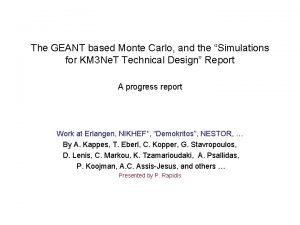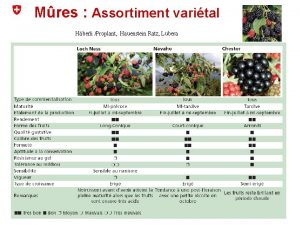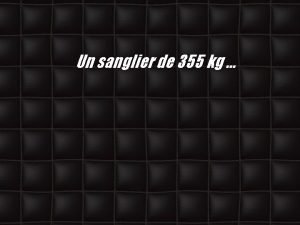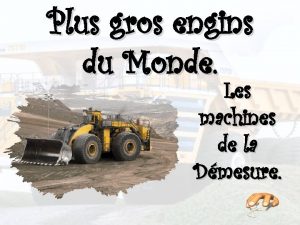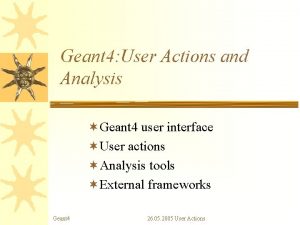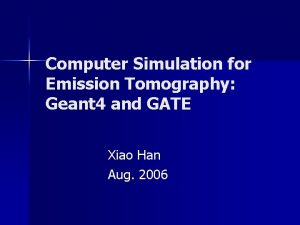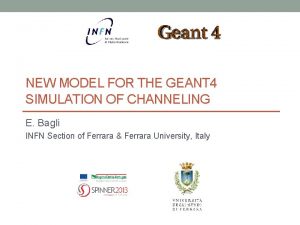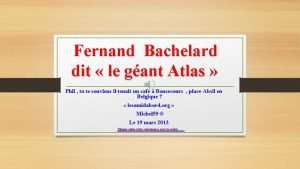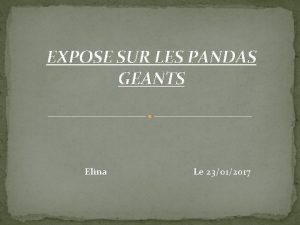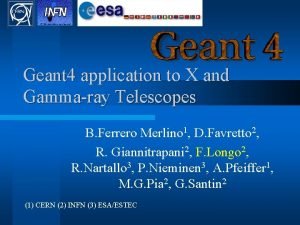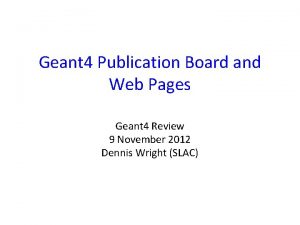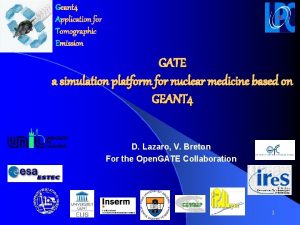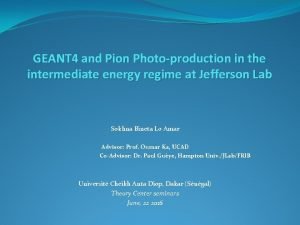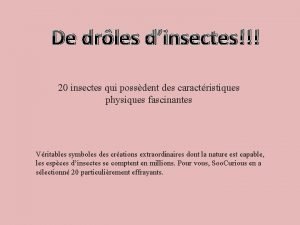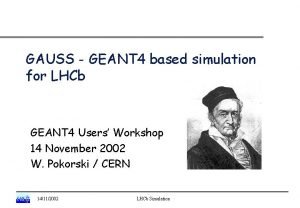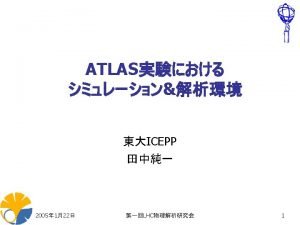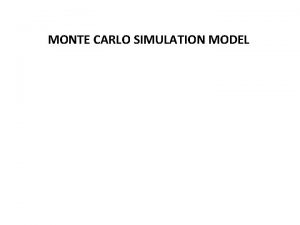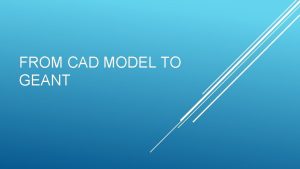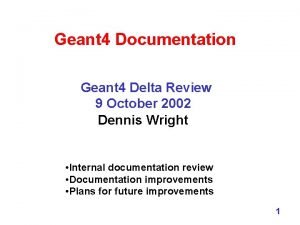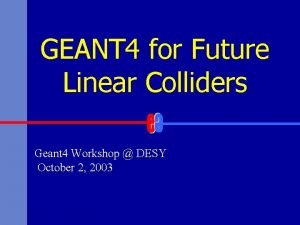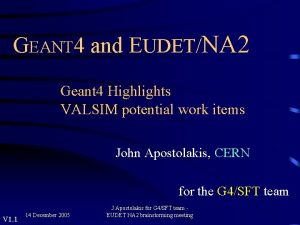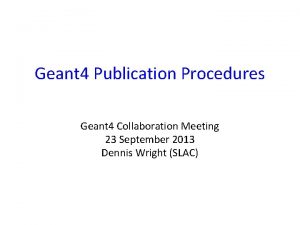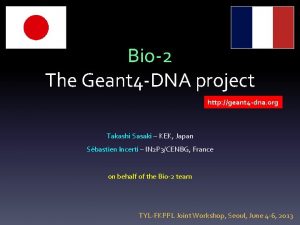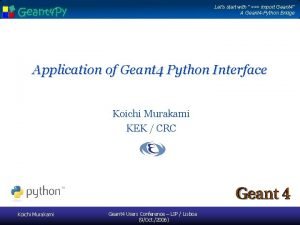NEW MODEL FOR THE GEANT 4 SIMULATION OF























- Slides: 23

NEW MODEL FOR THE GEANT 4 SIMULATION OF CHANNELING E. Bagli INFN Section of Ferrara & Ferrara University, Italy

Charged Particle Interaction Crystal Amorphous

Geant 4 Current Approach 1. The particle initial transverse energy is computed at the entrance of the crystal. This is the only information stored. 2. At each step, which can be limited by the other Geant 4 processes, the variation of transverse energy is computed. 3. If the particle is still under channeling, the momentum of the particle is aligned with the crystal planes, otherwise the particle leaves the channeling state and the momentum direction varies. 4. Under channeling, a modified value of nuclei and electron density is passed to the Geant 4 processes via the biasing technique.

Geant 4 processes modification Check If Volume Is a Crystal By modifying the trajectory of the particle and the density of the material “seen” by the particle the orientational effects in a crystal affect all the Geant 4 physical process. Check If Particle Is Under Channeling/VR The trajectories of channeled particles are “forced” to be tangent to crystal curvature. Channeling Process The density of materials seen by the channeled particles depends on transverse energy of the particles. Particle Trajectory Manipulation Material Density Modification

Crystal The crystal object is built adding to the standard Physical Volume the Crystal Structure in which the Unit Cell and the Lattice are defined. Physical Volume Logical Volume Solid Crystal Structure Unit cell Lattice

Crystal The crystal object is built adding to the standard Physical Volume the Crystal Structure in which the Unit Cell and the Lattice are defined. Physical Volume Logical Volume Solid Standard Geant 4 kernel Crystal Structure Unit cell Lattice Not implemented in standard Geant 4 kernel

Condition for channeling Straight crystal Bent crystal

Modified density starts, the table of the average density ratio vs. the transverse energy is computed or loaded. • The path is integrated over one oscillation period. Penetration Depth • Before the simulation Impact Position

Modified density Straight crystal Density Ratio Depending on the transverse energy of the particle, the density “seen” is different

Modified density • Nuclei and electron density tables are stored for positive and negative particles. • This approach can be used for crystal with dimension parallel to the beam much longer than the channeling oscillation period.

Geant 4 processes Discrete processes Continuous processes • The mean free path of the • Material density (ρ) for the discrete processes is recomputed at each step using the modified density because it is directly proportional to the density (ρ) of the material. calculation of continuous energy loss (d. E/dx) is modified at each step (dx=ρdz) to enable the reduction or the enhancement of the energy loss due to channeling.

Modified density Geant 4 Mean Free Path Modification Density Ratio (@20 e. V) Density Ratio = 1. 5 (@15 e. V) Density Ratio = 0. 8 Depending on the transverse energy of the particle, the density “seen” is different

Modified density • For negative particles the ratio is always higher than unity. Thus, the particles interact more frequently with nuclei and electrons in a crystal under coherent effects than in an amorphous media with the same average atomic density.

Geant 4 implementation Current Features • Only transverse energy variation tracked. • No information on exact position and momentum. • Longer step (Faster) than full numerical solution of equation of motion.

Geant 4 implementation Current New

Geant 4 implementation Possible features • Maintain current implementation of: • Modification of Geant 4 process cross-section. • Crystal classes. • Between each step solve exact trajectory. • Possibility to estimate: • • • Coherent radiation production. Influence of defects. Undulating structures. Mirror effect. … • Very slow. New

Geant 4 Current Approach - Pros • Positive and negative particles can be treated with same algorithm. Since the potential well is different and the integrated density varies. The approach allows the estimation of different channeling probability for positive and negative particles. • Modification of the cross section of the other phenomena is accounted thanks to the biasing techniques. Such technique is applicable to all the Geant 4 physics list via a specific package (M. Verderi work). • No limitation on crystal type. Only crystal information needed for the computation of potential and average density. • Every particle generated in a Geant 4 simulation may experience orientational processes. Thus, variation of shower is length for particle interacting with crystal can be simulated.

Geant 4 Current Approach - Cons • Because of lack of information on the trajectory • some phenomena can not be simulated with current version, e. g. , radiation production. • outgoing angle is computed via analytical equation depending on particle transverse energy • The mixed approach is compatible only with Geant 4 Single Scattering models and not with Geant 4 Multiple Scattering models. Thus, under channeling, the simulation is slower than standard Geant 4 simulation.

Geant 4 New Approach – Pros/Cons • Simulation of full particle trajectory. • The current classes can be updated in order to maintain • Implementation of crystal structures, which is independent from the channeling process • Modification of Geant 4 processes cross-section via the biasing technique. • Main consequences: • Terrible slowing down of the computation. • Possible to take into account all the orientational phenomena at high-energies. • Computation of the coherent radiation spectrum emitted by particles under coherent effects. • Modification of particle trajectory due to the presence of lattice variation, e. g. , undulating structure, defects, etc…

Coherent radiation in crystal Coherent Bremsstrahlung Penetration Depth Channeling radiation Impact Position

Channeling radiation • Channeled particle Penetration Depth oscillate between or on atomic planes. • The oscillatory motion lead the particle to emit radiation with a defined frequency. • The incoherent interaction modify the trajectory and lead the particle to generate photon with different energies. Impact Position

Coherent Bremsstrahlung particles which traverse the crystal with a small angle to the planes, but not under channeling (over-barrier particles) • Such particles are repeatedly attracted/repelled by the planes, generating coherent radiation. Penetration Depth • The same happens for Impact Position

Orientational effect in “deformed” crystals Half wavelength Mirror Penetration Depth Undulator Impact Position
 Geant simulation
Geant simulation Myrtillier géant
Myrtillier géant Geant network map
Geant network map Sanglier geant turquie
Sanglier geant turquie Plus gros camion de chantier
Plus gros camion de chantier Action geant
Action geant Geant computer
Geant computer Geant 4
Geant 4 Géant atlas voiture
Géant atlas voiture Panda exposé
Panda exposé Geant 4
Geant 4 Niconical
Niconical Pub geant
Pub geant Gate geant
Gate geant Pion geant
Pion geant Scutigere geant
Scutigere geant Kontinuitetshantering
Kontinuitetshantering Novell typiska drag
Novell typiska drag Tack för att ni lyssnade bild
Tack för att ni lyssnade bild Ekologiskt fotavtryck
Ekologiskt fotavtryck Varför kallas perioden 1918-1939 för mellankrigstiden?
Varför kallas perioden 1918-1939 för mellankrigstiden? En lathund för arbete med kontinuitetshantering
En lathund för arbete med kontinuitetshantering Kassaregister ideell förening
Kassaregister ideell förening Tidbok yrkesförare
Tidbok yrkesförare
